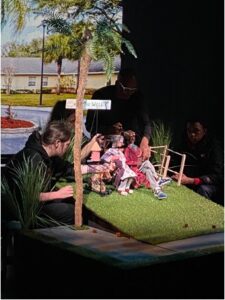By Ethan Horton
Friday, Oct. 8, 2021
Lauren Erickson decided she was going to keep her husband, Beau Bennett, alive until Friday. All she wanted was to stay with him a little bit longer.
He lay almost lifeless in an ICU bed, four days after suffering a major brain hemorrhage that separated the two halves of his brain.
Even if they were able to save him, the doctors said her husband would “never be Beau again.”
This was uncharacteristic for both of them — Beau was lifeless when he was usually boisterous, and Lauren was finally realizing he wouldn’t come back.
He’d been arrested, gone to a rehabilitation center and to the emergency room. But he always came back.
Lauren didn’t even realize at the time that Friday, Oct. 8, 2021 — the day Beau died — was their 10th wedding anniversary.
Now, she had to be the wife that kept everything together.
1999
Beau was working as a sauté chef at 411 West in Chapel Hill. Lauren was working as a hostess there, but she never saw Beau. He was always behind a wall of pots and pans.
But he could see her.
One night, after her shift ended, Lauren joined the rest of the staff in an alley beside the building — their place to escape from the noise and relax. Beau, with a Carolina blue bandana wrapped around his head, sat in the alley on an old wooden fence.
“Hey, I’m Beau. What’s your name?”
It was his name that drew Lauren in. Oh, and the bandana. She was a huge Poison fan, and his resemblance to lead singer Bret Michaels was undeniable.
From then on, they took things slow. Sometimes, even four years into their obvious relationship, Beau tried to jokingly tell friends that he and Lauren weren’t official.
Everyone knew they were, Lauren said.
They were best friends. He was her confidant, her everything.
2008
Everything Beau did was loud, Lauren said. Outrageous, even.
He spoke loud, his laugh was loud, and his feet stomped everywhere he went. He did what he wanted.
Beau wasn’t satisfied being a sauté chef. His personality was too big to be contained in the back of the restaurant. He wanted to be the star of the show.
In 2008, he founded Beau Catering, providing simple Southern food with a twist. He started out with just a cardboard box full of pots and pans and a Honda Accord. No staff, no kitchen.
Somehow, he managed to get a few clients, and he gathered family and friends for catering staff.
“It was beyond bootstraps,” Lauren said. “It was pure ignorance.”
The signature dish — the crab cakes — wasn’t the main attraction for Beau Catering, though.
Beau came out from the kitchen and announced the night’s menu to guests before every event — charisma overflowing, blue bandana still wrapped around his head.
For one wedding, the planner marked out time in the itinerary for “The Beau Show,” and the shtick stuck.
March 2020
After sitting at home during the beginning of the COVID-19 pandemic, the catering business completely halted in its tracks. Lauren and Beau were tired of doing nothing.
Luckily, an opportunity fell into their laps.
Carrboro United, a pandemic-era food initiative, started in March 2020 and helped bring more than $1 million back to the community.
Beau Catering signed up and they were busier than ever.
“We went from thinking we were going to… do yoga and stretch and chill in the yard to being very busy without any help,” Lauren said.
Lauren, who hadn’t been involved in the business much pre-pandemic, was thrust into the middle of it all.
She was cooking meals, handing them out and helping run the more practical side of the business, while Beau was off doing whatever Beau wanted to do.
Monday, Oct. 4, 2021
When Lauren walked in the front door after a work trip to Greensboro, she could hear Beau’s breathing from the other side of the house. He was loud, but not usually this loud.
Every single light in the house was out.
Confused, she walked to the back to check on him. For a second, she thought he was just asleep.
He was on the floor, unconscious and struggling to breathe. His phone was on the floor next to him. And he wasn’t waking up.
Beau’s health was notoriously outrageous, just like him, and Lauren had a lot of experience with her own dad’s constant health problems. She calmly packed Beau’s go-bag and headed to the hospital. She didn’t even bring anything of her own.
If Beau made it through jumping off of a pier at Atlantic Beach or falling in a rocky stream, he’d make it through this, Lauren thought.
No, she knew.
She’d been through the emergency room wasteland many times so she knew the procedure. Usually, it took a while for the doctors to come and talk to the family — but not this time.
The moment she walked in, a doctor pulled her into a dark, barren conference room.
“I knew at that moment, I knew it was not good,” she said.
She was going to miss him so much — she’d only have her flip book of memories.
The blue bandana. The apple box. The pier. The wedding. The fights. The loud steps. The dog house moments, both ways. The deep conversations that he would make you have with him. The Wendy’s trips that became adventures. The family beach trip they’d taken just the week before. The times he would miss meetings to drive around and have conversations with random people on the street. The smile. The laugh.
2023
Pictures of Beau in his blue bandana hang on the walls of Piedmont Food Processing Center, where Beau Catering is now housed. There are signs of his larger-than-life presence everywhere.
One of Beau’s hires, Katie Hopkins, is now the head chef and general manager. She wears a bandana at work, and has a blue one on the shelf next to her desk.
Lauren, who now owns a financial advising firm, is more involved with Beau Catering thanks to her COVID experience. She said Katie runs the place with much less emotion than Beau did — in some ways, for the better. With staffing turnovers, things have changed.
“There’s a lot of energy that Beau brought that, in theory, I have,” she said. “But it’s hard to have to bring it in a manufactured way when you feel so sad. When you lose your light, it’s hard to fake it. I can see that starting to come back with the team.”
On the chain-link door to a newly acquired storage space is a sign for Beau Catering. In the top left corner of the sign, there’s a note written in orange highlighter:
“You are missed.”
Edited by Courtney Hicks and Halsey Ziglar





